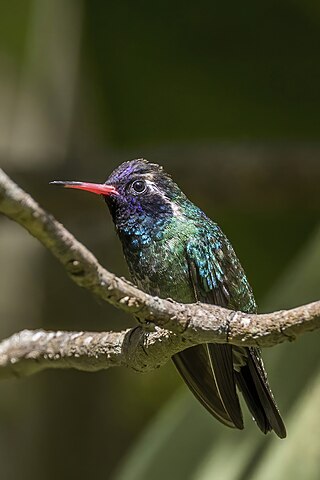
The violet sabrewing is a species of hummingbird in the "emeralds", tribe Trochilini of the subfamily Trochilinae. It is found from Mexico to Panama.

The purple-throated mountaingem is a species of hummingbird in tribe Lampornithini of subfamily Trochilinae. It is found in Costa Rica, Nicaragua, and Panama.

The garden emerald is a small hummingbird in the "emeralds", tribe Trochilini of subfamily Trochilinae. It is found in Costa Rica and Panama.

The bronze-tailed plumeleteer is a species of hummingbird in the "emeralds", tribe Trochilini of subfamily Trochilinae. It is found in Colombia, Costa Rica, Ecuador, Nicaragua, and Panama.

The white-eared hummingbird is a species of hummingbird in the "emeralds", tribe Trochilini of subfamily Trochilinae. It is found from the southwestern U.S. to Nicaragua.

The sapphire-spangled emerald is a species of hummingbird in the "emeralds", tribe Trochilini of subfamily Trochilinae. It is regularly found in Bolivia, Brazil, Peru, and Venezuela; as a vagrant in Argentina; and has possibly occurred in Ecuador.

The golden-crowned emerald is a species of hummingbird in the "emeralds", tribe Trochilini of subfamily Trochilinae. It is endemic to western Mexico.

The Chiribiquete emerald is a species of hummingbird in the "emeralds", tribe Trochilini of subfamily Trochilinae. It is endemic to southern Colombia.

The dusky hummingbird is a species of hummingbird in the "emeralds", tribe Trochilini of subfamily Trochilinae. It is endemic to Mexico.

Humboldt's sapphire or Humboldt's hummingbird is a species of hummingbird in the "emeralds", tribe Trochilini of subfamily Trochilinae. It is found in Colombia, Ecuador, and Panama.

The wedge-tailed hillstar is a species of hummingbird in the "coquettes", tribe Lesbiini of subfamily Lesbiinae. It is found in Argentina and Bolivia.

The hillstars are hummingbirds of the genus Oreotrochilus. They are native to the Andes in South America.

The Ecuadorian hillstar or Chimborazo hillstar is a species of hummingbird. It is native to the Andes of Ecuador and extreme southern Colombia. Its main habitat type is high-altitude mountain grassland between 3500 and 5200 meters.

The Andean hillstar is a species of hummingbird in the "coquettes", tribe Lesbiini of subfamily Lesbiinae. It is found in Argentina, Bolivia, Chile, and Peru.

The white-sided hillstar is a species of hummingbird in the "coquettes", tribe Lesbiini of subfamily Lesbiinae. It is found in Argentina, Bolivia, Chile.

The black-breasted hillstar is a species of hummingbird in the "coquettes", tribe Lesbiini of subfamily Lesbiinae. It is endemic to Peru.

The rufous-gaped hillstar, formerly included in the white-tailed hillstar, is a species of hummingbird in the "brilliants", tribe Heliantheini in subfamily Lesbiinae. It is found in Colombia and Ecuador.

The green-headed hillstar is a species of hummingbird found in the Andes of southern Ecuador and northern and central Peru. It is one of 6 species in the genus Oreotrochilus, and can be distinguished from its relatives by subtle differences in plumage coloration. The green-headed hillstar received its name due to its bronze and green crown and gorget of bright emerald green plumage. The species was first discovered by English ornithologist Osbert Salvin in 1895 and named after Polish ornithologist Jean Stanislaus Stolzmann.

The curve-winged sabrewing is a species of hummingbird in the "emeralds", tribe Trochilini of subfamily Trochilinae. It is endemic to Mexico.

The green-backed hillstar, formerly included in the white-tailed hillstar, is a species of hummingbird in the "brilliants", tribe Heliantheini in subfamily Lesbiinae. It is found in Colombia, Ecuador, and Peru.





















